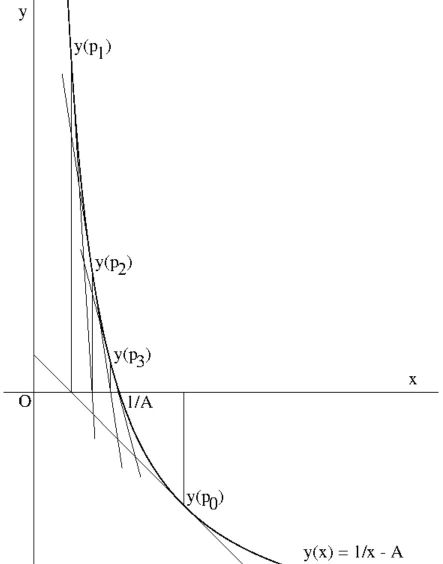

Thus by employing the Newton-Raphson algorithm, the inverse of a number can be
found with quadratic speed, by performing solely additions and multiplications.
Armed with this knowledge, let's make the transition from numbers to matrices.
Determining the inverse of a matrix, filled with many numbers, seems to be much
more like a challenge anyway.
Let the iterative process for matrices be defined by: $$
P_0 = I \quad \mbox{and} \quad P_{n+1} = 2.P_n - A.P_n.P_n $$
Here $I$ is the unity matrix, $A$ is the matrix to be inverted and $P_n$ are
the successive iterands, which should converge to the inverse matrix $A^{-1}$.
Theorem.
$$
\mbox{Let} \quad M = (I - A) \quad \mbox{or} \quad A = (I - M) \quad
\mbox{then:} \quad P_n = (I - M^{2^n}) . A^{-1}
$$
Proof by induction:
$$
\begin{array}{lll}
P_0 &=& I = A . A^{-1} = (I - M) . A^{-1} \\
P_{n+1} &=& \left(I - M^{2^{n+1}} \right) . A^{-1} \\
&=& \left(I - M^{2^n.2} \right) . A^{-1} \\
&=& \left[I - (M^{2^n})^2 \right] . A^{-1} \\
&=& \left(I - M^{2^n} \right) .
\left(I + M^{2^n} \right) . A^{-1} \\
&=& \mbox{because all matrices are mutually commutative:} \\
&=& \left(I - M^{2^n} \right) . A^{-1} .
\left[ 2.I - A.\left( I - M^{2^n} \right).A^{-1} \right] \\
&=& P_n.(2.I - A.P_n) = 2.P_n - A.P_n.P_n
\end{array}
$$
Let $m = 2^n$, then:
$$
P_n = (I - M^m) . (I-M)^{-1}
$$
For numbers, this would be the sum of a Geometric series :
$$
(I - M^m).(I - M)^{-1} =
(I + M + M^2 + M^3 + M^4 + M^5 + M^6 + ... + M^{m-1})
$$
For matrices, this Geometric Series turns out to be equivalent to an iterative
"incremental Jacobi" solution method, as will not be futher explained here.
But there also does exist a product of terms, called the Euler expansion
(don't remember where the naming comes from; a reference would be quite welcome):
$$
(I - M^m).(I - M)^{-1} = \\
(I + M^{m/2}).(I - M^{m/2}).(I - M)^{-1} = \\
(I + M^{m/2}).(I + M^{m/4}).(I - M^{m/4}).(I - M)^{-1} = \\
(I + M^{m/2}).(I + M^{m/4}). \, ... \, (I+M^2).(I+M).(I-M).(I-M)^{-1} = \\
(I + M^{m/2}).(I + M^{m/4}). \, ... \, (I + M^8).(I + M^4).(I + M^2).(I + M)
$$
Let the system of equations to be solved be given by $A.w = b$. Using the above
sequences, we can write:
$$
P_n = (I - M^{2^n}) . A^{-1} \quad \Longrightarrow \quad
A^{-1} b = (I - M^{2^n})^{-1} . P_n b
$$ $$
= (I - M^{2^n})^{-1} .
(I + M^{m/2}).(I + M^{m/4}). \, ... \, (I + M^8).(I + M^4).(I + M^2).(I + M) b
$$
Another way of looking at this is the following:
$$
(I-M)^{-1} = (I-M)^{-1}.(I+M)^{-1}.(I+M) = (I-M^2)^{-1}.(I+M) = \\
(I-M^2)^{-1}.(I+M^2)^{-1}.(I+M^2).(I+M) = (I-M^4)^{-1}.(I+M^2).(I+M)
$$
With other words:
$$
w = (I-M)^{-1}.b = (I-M)^{-1}.(I+M)^{-1}.(I+M).b = (I-M^2)^{-1}.(I+M).b
$$
Define $b := (I + M).b$ and $M := M^2$. Then again:
$$
w = (I-M)^{-1}.b = (I-M)^{-1}.(I+M)^{-1}.(I+M).b = (I-M^2)^{-1}.(I+M).b
$$
And this process can be repeated until we find a way to determine $(I-M)^{-1}$,
preferrably without continuing the iterations ad infinitum.
Update. Quite in general, the inverse of a sparse matrix
is not sparse at all. And this, of course, will be
reflected in the iterands of the Newton-Schulz method for obtaining
an approximate inverse. The common remedy is simply not to calculate
the inverse of a large sparse matrix and use e.g.
LU decomposition instead.
But, as argued in the abovementioned reference,
the Newton-Schulz method may be regarded as an Ansatz to MultiGrid
methods. And that is a quite different story, not to be elaborated here.